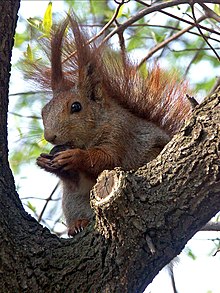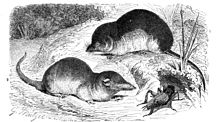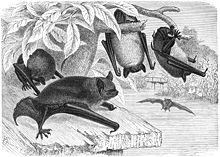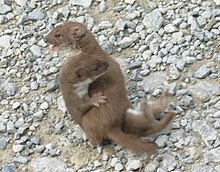bio.wikisort.org - Animal
There are 75 mammal species in Slovenia, of which seven are vulnerable and four are near threatened.[1]
The following tags are used to highlight each species' conservation status as assessed by the International Union for Conservation of Nature:
| EX | Extinct | No reasonable doubt that the last individual has died. |
| EW | Extinct in the wild | Known only to survive in captivity or as a naturalized populations well outside its previous range. |
| CR | Critically endangered | The species is in imminent risk of extinction in the wild. |
| EN | Endangered | The species is facing an extremely high risk of extinction in the wild. |
| VU | Vulnerable | The species is facing a high risk of extinction in the wild. |
| NT | Near threatened | The species does not meet any of the criteria that would categorise it as risking extinction but it is likely to do so in the future. |
| LC | Least concern | There are no current identifiable risks to the species. |
| DD | Data deficient | There is inadequate information to make an assessment of the risks to this species. |
Order: Rodentia (rodents)




Rodents make up the largest order of mammals, with over 40% of mammalian species. They have two incisors in the upper and lower jaw which grow continually and must be kept short by gnawing. Most rodents are small though the capybara can weigh up to 45 kg (99 lb).

- Suborder: Sciurognathi
- Family: Castoridae (beavers)
- Genus: Castor
- Eurasian beaver, C. fiber LC[2]
- Genus: Castor
- Family: Sciuridae (squirrels)
- Subfamily: Sciurinae
- Tribe: Sciurini
- Genus: Sciurus
- Red squirrel, Sciurus vulgaris NT
- Genus: Sciurus
- Tribe: Sciurini
- Subfamily: Xerinae
- Tribe: Marmotini
- Genus: Marmota
- Alpine marmot, Marmota marmota LC
- Genus: Marmota
- Tribe: Marmotini
- Subfamily: Sciurinae
- Family: Gliridae (dormice)
- Subfamily: Leithiinae
- Genus: Dryomys
- Forest dormouse, Dryomys nitedula
- Genus: Eliomys
- Garden dormouse, Eliomys quercinus VU
- Genus: Muscardinus
- Hazel dormouse, Muscardinus avellanarius
- Genus: Dryomys
- Subfamily: Glirinae
- Genus: Glis
- European edible dormouse, Glis glis
- Genus: Glis
- Subfamily: Leithiinae
- Family: Cricetidae
- Subfamily: Cricetinae
- Genus: Cricetus
- European hamster, C. cricetus CR[3]
- Genus: Cricetus
- Subfamily: Arvicolinae
- Genus: Arvicola
- Water vole, Arvicola terrestris
- Genus: Chionomys
- Snow vole, Chionomys nivalis
- Genus: Clethrionomys
- Bank vole, Clethrionomys glareolus
- Genus: Microtus
- Field vole, Microtus agrestis
- Common vole, Microtus arvalis
- European pine vole, Microtus subterraneus
- Genus: Arvicola
- Subfamily: Cricetinae
- Family: Muridae (mice, rats, voles, gerbils, hamsters)
- Subfamily: Murinae
- Genus: Apodemus
- Yellow-necked mouse, Apodemus flavicollis LC
- Wood mouse, Apodemus sylvaticus LC
- Genus: Micromys
- Harvest mouse, Micromys minutus
- Genus: Mus
- Steppe mouse, Mus spicilegus
- Genus: Apodemus
- Subfamily: Murinae
- Family: Castoridae (beavers)
Order: Lagomorpha (lagomorphs)

The lagomorphs comprise two families, Leporidae (hares and rabbits), and Ochotonidae (pikas). Though they can resemble rodents, and were classified as a superfamily in that order until the early 20th century, they have since been considered a separate order. They differ from rodents in a number of physical characteristics, such as having four incisors in the upper jaw rather than two.
- Family: Leporidae (rabbits, hares)
Order: Erinaceomorpha (hedgehogs and gymnures)

The order Erinaceomorpha contains a single family, Erinaceidae, which comprise the hedgehogs and gymnures. The hedgehogs are easily recognised by their spines while gymnures look more like large rats.
- Family: Erinaceidae (hedgehogs)
- Subfamily: Erinaceinae
- Genus: Erinaceus
- Southern white-breasted hedgehog, E. concolor LC
- West European hedgehog, E. europaeus LC[6]
- Genus: Erinaceus
- Subfamily: Erinaceinae
Order: Soricomorpha (shrews, moles, and solenodons)



The "shrew-forms" are insectivorous mammals. The shrews and solenodons closely resemble mice while the moles are stout-bodied burrowers.
- Family: Soricidae (shrews)
- Subfamily: Crocidurinae
- Genus: Crocidura
- Bicolored shrew, Crocidura leucodon
- Lesser white-toothed shrew, Crocidura suaveolens
- Genus: Crocidura
- Subfamily: Soricinae
- Tribe: Nectogalini
- Genus: Neomys
- Southern water shrew, Neomys anomalus
- Eurasian water shrew, Neomys fodiens
- Genus: Neomys
- Tribe: Soricini
- Genus: Sorex
- Alpine shrew, Sorex alpinus
- Common shrew, Sorex araneus
- Genus: Sorex
- Tribe: Nectogalini
- Subfamily: Crocidurinae
- Family: Talpidae (moles)
- Subfamily: Talpinae
- Tribe: Talpini
- Genus: Talpa
- Mediterranean mole, Talpa caeca
- European mole, Talpa europaea
- Stankovic's mole, Talpa stankovici
- Genus: Talpa
- Tribe: Talpini
- Subfamily: Talpinae
Order: Chiroptera (bats)




The bats' most distinguishing feature is that their forelimbs are developed as wings, making them the only mammals capable of flight. Bat species account for about 20% of all mammals.
- Family: Vespertilionidae
- Subfamily: Myotinae
- Genus: Myotis
- Bechstein's bat, M. bechsteini NT[7]
- Lesser mouse-eared bat, M. blythii LC[8]
- Long-fingered bat, M. capaccinii VU[9]
- Daubenton's bat, M. daubentonii LC[10]
- Geoffroy's bat, M. emarginatus LC[11]
- Greater mouse-eared bat, M. myotis LC[12]
- Whiskered bat, M. mystacinus LC[13]
- Natterer's bat, M. nattereri LC[14]
- Genus: Myotis
- Subfamily: Vespertilioninae
- Subfamily: Miniopterinae
- Genus: Miniopterus
- Common bent-wing bat, M. schreibersii VU[28]
- Genus: Miniopterus
- Subfamily: Myotinae
- Family: Rhinolophidae
Order: Cetacea (whales)

The order Cetacea includes whales, dolphins and porpoises. They are the mammals most fully adapted to aquatic life with a spindle-shaped nearly hairless body, protected by a thick layer of blubber, and forelimbs and tail modified to provide propulsion underwater.
- Suborder: Mysticeti
- Family: Balaenopteridae
- Genus: Balaenoptera
- Fin whale, Balaenoptera physalus EN
- Genus: Balaenoptera
- Family: Balaenopteridae
- Suborder: Odontoceti
- Superfamily: Platanistoidea
- Family: Delphinidae (marine dolphins)
- Genus: Delphinus
- Short-beaked common dolphin, Delphinus delphis
- Genus: Grampus
- Risso's dolphin, Grampus griseus DD
- Genus: Tursiops
- Common bottlenose dolphin, Tursiops truncatus
- Genus: Delphinus
- Family: Delphinidae (marine dolphins)
- Superfamily: Platanistoidea
Order: Carnivora (carnivorans)



There are over 260 species of carnivorans, the majority of which feed primarily on meat. They have a characteristic skull shape and dentition.
- Suborder: Feliformia
- Suborder: Caniformia
- Family: Canidae (dogs, foxes)
- Family: Ursidae (bears)
- Genus: Ursus
- Brown bear, U. arctos LC[39]
- Genus: Ursus
- Family: Mustelidae (mustelids)
Order: Artiodactyla (even-toed ungulates)

The even-toed ungulates are ungulates whose weight is borne about equally by the third and fourth toes, rather than mostly or entirely by the third as in perissodactyls. There are about 220 artiodactyl species, including many that are of great economic importance to humans.
- Family: Suidae (pigs)
- Subfamily: Suinae
- Genus: Sus
- Wild boar, S. scrofa LC[47]
- Genus: Sus
- Subfamily: Suinae
- Family: Cervidae (deer)
- Family: Bovidae (bovids)
- Subfamily: Caprinae
- Genus: Capra
- Alpine ibex, C. ibex LC introduced
- Genus: Capra
- Subfamily: Caprinae
Locally extinct
The following species are locally extinct in the country:
- Mediterranean monk seal, Monachus monachus[50]
See also
- List of chordate orders
- Lists of mammals by region
- List of prehistoric mammals
- Mammal classification
- List of mammals described in the 2000s
Notes
- This list is derived from the IUCN Red List which lists species of mammals and includes those mammals that have recently been classified as extinct (since 1500 AD). The taxonomy and naming of the individual species is based on those used in existing Wikipedia articles as of 21 May 2007 and supplemented by the common names and taxonomy from the IUCN, Smithsonian Institution, or University of Michigan where no Wikipedia article was available.
- Batbold, J.; Batsaikhan, N.; Shar, S.; Hutterer, R.; Kryštufek, B.; Yigit, N.; Mitsain, G.; Palomo, L. (2016). "Castor fiber". IUCN Red List of Threatened Species. 2016: e.T4007A115067136.
- Banaszek, A.; Bogomolov, P.; Feoktistova, N.; La Haye, M.; Monecke, S.; Reiners, T. E.; Rusin, M.; Surov, A.; Weinhold, U. & Ziomek, J. (2020). "Cricetus cricetus". IUCN Red List of Threatened Species. 2020: e.T5529A111875852.
- Hacklande, K. & Schai-Braun, S. (2019). "Lepus europaeus". IUCN Red List of Threatened Species. 2019: e.T41280A45187424.
- Smith, A.T. & Johnston, C.H. (2019). "Lepus timidus". IUCN Red List of Threatened Species. 2019: e.T11791A45177198.
- Amori, G.; Hutterer, R.; Kryštufek, B.; Yigit, N.; Mitsain, G. & Palomo, L. J. (2008). "Erinaceus europaeus". IUCN Red List of Threatened Species. 2008: e.T29650A9508000.
- Paunović, M. (2019). "Myotis bechsteinii". IUCN Red List of Threatened Species. 2019: e.T14123A22053752.
- Juste, J. & Paunović, M. (2016). "Myotis blythii". IUCN Red List of Threatened Species. 2016: e.T14124A22053297.
- Hutson, A. M.; Spitzenberger, F.; Aulagnier, S.; Juste, J.; Karatas, A.; Palmeirim, J. & Paunovic, M. (2010). "Myotis capaccinii". IUCN Red List of Threatened Species. 2010: e.T14126A4399043.
- Kruskop, S.V.; Godlevska, L.; Bücs, S.; Çoraman, E. & Gazaryan, S. (2020). "Myotis daubentonii". IUCN Red List of Threatened Species. 2020: e.T85342710A22054773.
- Piraccini, R. (2016). "Myotis emarginatus". IUCN Red List of Threatened Species. 2016: e.T14129A22051191.
- Coroiu, I.; Juste, J. & Paunović, M. (2016). "Myotis myotis". IUCN Red List of Threatened Species. 2016: e.T14133A22051759.
- Coroiu, I. (2016). "Myotis mystacinus". IUCN Red List of Threatened Species. 2016: e.T14134A22052250.
- Gazaryan, S.; Kruskop, S.V. & Godlevska, L. (2020). "Myotis nattereri". IUCN Red List of Threatened Species. 2020: e.T85733032A22052584.
- Piraccini, R. (2016). "Barbastella barbastellus". IUCN Red List of Threatened Species. 2016: e.T2553A22029285.
- Coroiu, I. (2016). "Eptesicus nilssonii". IUCN Red List of Threatened Species. 2016: e.T7910A22116204.
- Godlevska, L.; Kruskop, S.V.; Gazaryan, S. (2020) [amended version of 2020 assessment]. "Eptesicus serotinus". IUCN Red List of Threatened Species. 2020: e.T85199559A195834153.
- Hutson, A. M.; Spitzenberger, F.; Juste, J.; Aulagnier, S.; Palmeirim, J.; Paunovic, M. & Karatas, A. (2010). "Hypsugo savii". IUCN Red List of Threatened Species. 2010: e.T44856A10955205.
- Hutson, A. M.; Alcaldé, J. T.; Juste, J.; Karataş, A.; Palmeirim, J. & Paunović, M. (2010). "Nyctalus lasiopterus". IUCN Red List of Threatened Species. 2010: e.T14918A4471682.
- Juste, J. & Paunović, M. (2016). "Nyctalus leisleri". IUCN Red List of Threatened Species. 2016: e.T14919A22016159.
- Csorba, G. & Hutson, A.M. (2016). "Nyctalus noctula". IUCN Red List of Threatened Species. 2016: e.T14920A22015682.
- Godlevska, L.; Bücs, S.; Kruskop, S.V.; Gazaryan, S.; Benda, P. & Paunović, M. (2021) [errata version of 2020 assessment]. "Pipistrellus pipistrellus". IUCN Red List of Threatened Species. 2020: e.T85333513A196581936.
- Juste, J. & Paunović, M. (2016). "Pipistrellus kuhlii". IUCN Red List of Threatened Species. 2016: e.T17314A22132946.
- Hutson, A. M.; Spitzenberger, F.; Juste, J.; Aulagnier, S.; Palmeirim, J.; Karatas, A. & Paunovic, M. (2010). "Pipistrellus nathusii". IUCN Red List of Threatened Species. 2010: e.T17316A6966886.
- Gazaryan, S.; Kruskop, S.V. & Godlevska, L. (2021) [errata version of 2020 assessment]. "Plecotus auritus". IUCN Red List of Threatened Species. 2020: e.T85535522A195861341.
- Gazaryan, S. & Godlevska, L. (2020) [amended version of 2020 assessment]. "Plecotus austriacus". IUCN Red List of Threatened Species. 2020: e.T85533333A195862345.
- Coroiu, I. (2016). "Vespertilio murinus". IUCN Red List of Threatened Species. 2016: e.T22947A22071456.
- Gazaryan, S.; Bücs, S. & Çoraman, E. (2021) [errata version of 2020 assessment]. "Miniopterus schreibersii". IUCN Red List of Threatened Species. 2020: e.T81633057A19585652.
- Juste, J. & Alcaldé, J. (2016). "Rhinolophus euryale". IUCN Red List of Threatened Species. 2016: e.T19516A21971185.
- Piraccini, R. (2016). "Rhinolophus ferrumequinum". IUCN Red List of Threatened Species. 2016: e.T19517A21973253.
- Taylor, P. (2016). "Rhinolophus hipposideros". IUCN Red List of Threatened Species. 2016: e.T19518A21972794.
- Alcaldé, J.; Benda, P. & Juste, J. (2016). "Rhinolophus mehelyi". IUCN Red List of Threatened Species. 2016: e.T19519A21974380.
- Gerngross, P.; Ambarli, H.; Angelici, F.M.; Anile, S.; Campbell, R.; Ferreras de Andres, P.; Gil-Sanchez, J.M.; Götz, M.; Jerosch, S.; Mengüllüoglu, D.; Monterosso, P. & Zlatanova, D. (2022). "Felis silvestris". IUCN Red List of Threatened Species. 2022: e.T181049859A181050999. doi:10.2305/IUCN.UK.2022-1.RLTS.T181049859A181050999.en. Retrieved 3 August 2022.
- Breitenmoser, U.; Breitenmoser-Würsten, C.; Lanz, T.; von Arx, M.; Antonevich, A.; Bao, W. & Avgan, B. (2015). "Lynx lynx". IUCN Red List of Threatened Species. 2015: e.T12519A121707666.
- Hoffmann, M. & Sillero-Zubiri, C. (2016). "Vulpes vulpes". IUCN Red List of Threatened Species. 2016: e.T23062A46190249.
- Hoffmann, M.; Arnold, J.; Duckworth, J. W.; Jhala, Y.; Kamler, J. F. & Krofel, M. (2018). "Canis aureus". IUCN Red List of Threatened Species. 2018: e.T118264161A46194820.
- Boitani, L.; Phillips, M. & Jhala, Y. (2018). "Canis lupus". IUCN Red List of Threatened Species. 2018: e.T3746A119623865.
- Kauhala, K.; Saeki, M. (2016). "Nyctereutes procyonoides". IUCN Red List of Threatened Species. 2016: e.T14925A85658776.
- McLellan, B. N.; Proctor, M. F.; Huber, D. & Michel, S. (2017). "Ursus arctos". IUCN Red List of Threatened Species. 2017: e.T41688A121229971.
- Roos, A.; Loy, A.; de Silva, P.; Hajkova, P. & Zemanová, B. (2015). "Lutra lutra". IUCN Red List of Threatened Species. 2015: e.T12419A21935287.
- Abramov, A.V.; Kranz, A.; Herrero, J.; Krantz, A.; Choudhury, A. & Maran, T. (2016). "Martes foina". IUCN Red List of Threatened Species. 2016: e.T29672A45202514.
- Kranz, A.; Abramov, A. V.; Herrero, J. & Maran, T. (2016). "Meles meles". IUCN Red List of Threatened Species. 2016: e.T29673A45203002.
- Reid, F.; Helgen, K. & Kranz, A. (2016). "Mustela erminea". IUCN Red List of Threatened Species. 2016: e.T29674A45203335.
- McDonald, R. A.; Abramov, A. V.; Stubbe, M.; Herrero, J.; Maran, T.; Tikhonov, A.; Cavallini, P.; Kranz, A.; Giannatos, G.; Kryštufek, B. & Reid, F. (2019). "Mustela nivalis". IUCN Red List of Threatened Species. 2019: e.T70207409A147993366.
- Skumatov, D.; Abramov, A.V.; Herrero, J.; Kitchener, A.; Maran, T.; Kranz, A.; Sándor, A.; Stubbe, M.; Saveljev, A.; Savour-Soubelet, A.; Guinot-Ghestem, M.; Zuberogoitia, I.; Birks, J.D.S.; Weber, A.; Melisch, R. & Ruette, S. (2016). "Mustela putorius". IUCN Red List of Threatened Species. 2016: e.T41658A45214384.
- Reid, F.; Schiaffini, M. & Schipper, J. (2016). "Neovison vison". IUCN Red List of Threatened Species. 2016: e.T41661A45214988.
- Keuling, O. & Leus, K. (2019). "Sus scrofa". IUCN Red List of Threatened Species. 2019: e.T41775A44141833.
- Lovari, S.; Lorenzini, R.; Masseti, M.; Pereladova, O.; Carden, R.F.; Brook, S.M. & Mattioli, S. (2018). "Cervus elaphus". IUCN Red List of Threatened Species. 2018: e.T55997072A142404453.
- Lovari, S.; Herrero, J.; Masseti, M.; Ambarli, H.; Lorenzini, R. & Giannatos, G. (2016). "Capreolus capreolus". IUCN Red List of Threatened Species. 2016: e.T42395A22161386.
- Karamanlidis, A. & Dendrinos, P. (2015). "Monachus monachus". IUCN Red List of Threatened Species. 2015: e.T13653A45227543.
References
- "The IUCN Red List of Threatened Species: Mammals of Slovenia". IUCN. 2001. Retrieved 22 May 2007. [dead link]
- "Mammal Species of the World". Smithsonian National Museum of Natural History. 2005. Archived from the original on 27 April 2007. Retrieved 22 May 2007.
- "Animal Diversity Web". University of Michigan Museum of Zoology. 1995–2006. Retrieved 22 May 2007.
Другой контент может иметь иную лицензию. Перед использованием материалов сайта WikiSort.org внимательно изучите правила лицензирования конкретных элементов наполнения сайта.
WikiSort.org - проект по пересортировке и дополнению контента Википедии